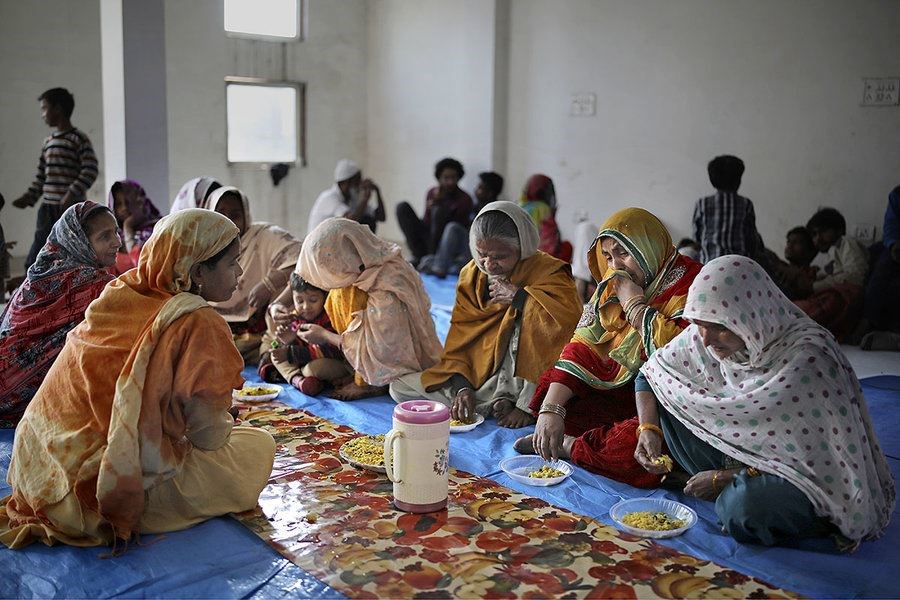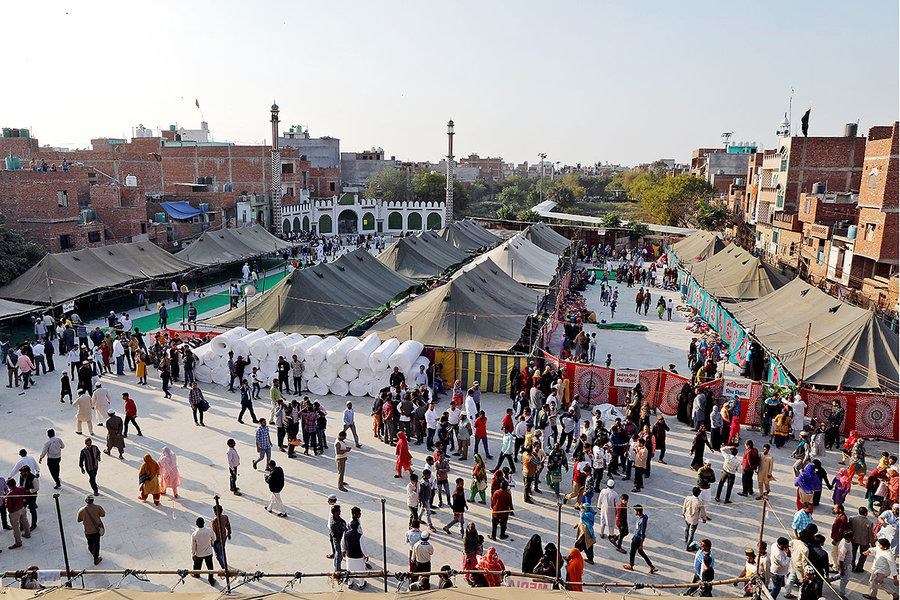REPRINTED WITH PERMISSION FROM THE CHRISTIAN SCIENCE MONITOR
One of the casualties of Delhi’s riots is trust: trust that India’s capital is safe for Muslims and Hindus alike, despite historic tensions. Yet even with those doubts, neighbors are helping each other rebuild some sense of security.
MARCH 10, 2020 - NEW DELHI - At sundown, Tabassum walked around the narrow corridors of a buzzing Al Hind hospital, exchanging a few words with other women. Dressed in a pink salwar kameez, with a black floral scarf wrapped around her head, her eyes frequently darted back to her acquaintance Rubina Bano. Three months pregnant, Ms. Bano sat on a bench with a bandaged head.
 Muslim women whose homes were attacked sob while eating a meal inside a hall at Al Hind hospital, which is doubling as a shelter, in Old Mustafabad neighborhood of New Dehli, India on Feb. 28, 2020. The hospital in the riot-torn neighborhood turned form a community clinic into a trauma ward after violence that left dozens dead and hundreds injured.Altaf Qadri/AP
Muslim women whose homes were attacked sob while eating a meal inside a hall at Al Hind hospital, which is doubling as a shelter, in Old Mustafabad neighborhood of New Dehli, India on Feb. 28, 2020. The hospital in the riot-torn neighborhood turned form a community clinic into a trauma ward after violence that left dozens dead and hundreds injured.Altaf Qadri/AP
For Tabassum, these surroundings had already grown familiar. For the past week, she had taken shelter on the hospital’s once-vacant first floor with her two young daughters. Sandwiched between a tailor shop and a jewelry store in the narrow bylanes of Mustafabad, a Muslim-dominated neighborhood in northeast Delhi, the small private hospital has become a refuge for those affected by the capital’s worst sectarian riots in decades.
“Things are okay here, but every time I recall what happened with us, it gets difficult and I feel like I am slipping into depression,” says Tabassum, who asked to go by one name for her safety, before quickly collecting herself.
Ten days after the violence and arson subsided, leaving 53 people dead, more than 2,000 people have been arrested or detained. The government has set up a relief camp, where more than 1,000 people are now taking shelter. State ministers are visiting affected areas and asking officials to speed up their efforts, according to local reports.
But the city and federal governments’ response has been sharply criticized. Residents interviewed for this article, and in other reports, alleged that police were slow to respond, or complicit in attacks. The Delhi Minorities Commission concluded in a report that the violence was “one-sided and well-planned” against Muslims.
Meanwhile, it has been largely places like Al Hind, and residents of the most affected neighborhoods, who are trying to put lives together again.
“We were three doctors and two staff that day,” recalls M. Ahtesham Anwar, remembering the scene on Feb. 24 – the first of several days of clashes. He runs Al Hind with his brothers, the two other doctors he refers to. “All the shops, chemists, and clinics in the area were shut. The injured were queuing up here.”
 A relief camp, photographed March 3, has been set up in Mustafabad, in northeast New Delhi, after people fled their homes following Hindu-Muslim clashes triggered by a new citizenship law.Anushree Fadnavis/Reuters
A relief camp, photographed March 3, has been set up in Mustafabad, in northeast New Delhi, after people fled their homes following Hindu-Muslim clashes triggered by a new citizenship law.Anushree Fadnavis/Reuters
“That’s when we decided we wouldn’t ask anyone for their name, caste, religion, or locality, nor would we charge them. Because these things make people anxious. We worked continuously and did what we could.”
At the height of the violence, the entire first floor was lined up with mattresses, with ropes tied across the hall to hang IV drip-feeds. Supplies and expertise were running low, and locals stepped up to assist: providing blankets, mattresses, and food; cleaning bloodied floors; and helping the wounded.
Amid the chaos, the doctors’ main goal was simple, Dr. Anwar adds. “We tried to assure them that they would live.”
Before February’s violence, communal tensions had been building for weeks. Since December, millions of Indians across the country have been protesting the passage of the Citizenship Amendment Act (CAA), which grants citizenship to non-Muslim refugees from Pakistan, Bangladesh, and Afghanistan who face religious persecution. Prime Minister Narendra Modi’s governing party has also proposed a national register of citizens, intended to identify undocumented immigrants. Together with the law, many citizens fear, the register could be used as a tool to discriminate against Indian Muslims who lack proper paperwork – adding to years of mounting concern about rising Hindu nationalism.
After the attacks began, mobs and police prevented ambulances from going to or from Al Hind, staff said, as workers tried to transport the injured to government hospitals where they could receive better care. At an emergency midnight hearing on Feb. 26 the Delhi High Court passed an orderdirecting the police to ensure safe passage. By the 28th, the hospital had attended to about 600 people, a third of whom suffered firearm injuries.
Tabassum and Ms. Bano had frequently taken part in anti-CAA protests in the area, though Tabassum was working at home when the attacks began. Like many victims, she says she is not ready to return home. As the violence began, she locked her house and hid inside with her daughters for three days before escaping to Al Hind.
“We heard gunshots, tear gases being fired, there was smoke everywhere and our room was so hot because the houses nearby were burning,” Tabassum recalls.
Santhosh Kumar, an orthopedic surgeon and vice president of Doctors Without Borders’ South Asia Regional Association, is in Delhi to volunteer. The situation feels eerily similar, he says, to the Gujarat riots in 2002, in which over 1,000 people, mostly Muslim, were killed. Mr. Modi, then chief minister of Gujarat state, has denied accusations that his government was complicit in the riots or failed to control them, and Indian courts have cleared the allegations.
“Things changed for the country the moment this government came into power,” Dr. Kumar says. “Unless the civil society and the communities come together in a different, harder or more innovative way against this, it is going to continue.”
Dr. Anwar believes that it is important, as a community, to be hopeful and focus on the healing process. “I never imagined something of this scale happening, especially in the Indian capital. ... I was made to feel like I may not survive,” he said. “But it is our responsibility now to find the way ahead.”
Outside the hospital, too, locals are stepping in to help the displaced with medical care, legal aid, and to collect relief. University students, who were at the forefront of the anti-CAA protests, are assisting with recovery as well.
About half a mile from Al Hind, residents have opened up their homes to volunteers. The living room of Haji Mohammad Dilshad has been converted into a medical camp where doctors tend to patients pouring in at every moment, including one who has taken sick leave from her hospital to volunteer. One of Mr. Dilshad’s neighbor’s rooms is strewn with files and forms, serving as a legal camp. Lawyers here have been helping those affected fill the government's compensation forms and file complaints.
Across the street, the five floors of a madrassa religious school have been converted into a relief camp. Social workers, however, pointed out that many people were initially fearful of taking shelter in a religious building, having seen mosques destroyed during the violence.
During the attack, neighbors on the street say, they worked together to build a barricade for protection, and called the police helpline repeatedly but did not receive assistance – heightening their sense of responsibility for each other. Delhi had become unsafe not because of the people but because of the government, they reasoned. Mr. Dilshad and other men have been taking turns to stay up at night and keep watch.
“We [Hindus and Muslims] live together and work together but there is an atmosphere of fear and distrust now,” says Mr. Dilshad, whose warehouse was damaged during the riots. “But it can’t get worse because people here are sensible. If we keep helping out in whatever way we can, things will return to normalcy soon.”
In the eyes of Mishika Singh, a lawyer volunteering to help anti-CAA protesters and people displaced by the violence, normalcy is still distant.
“People are so emboldened. They’re coming and setting houses on fire knowing that nothing will be done to them. That kind of confidence, by people causing riots, I’ve never seen here,” she says. “The only hope right now is that if there are two people helping today, because of the situation (getting worse) tomorrow, there will be 2,000 people helping. These are mostly young people on the ground, so that is hopeful.”
Page created on 3/10/2020 6:16:30 PM
Last edited 3/10/2020 6:29:06 PM
